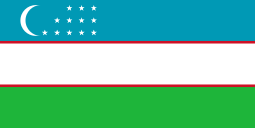Bolo Haouz Mosque
Bolo Haouz Mosque is a historical mosque in Bukhara, Uzbekistan.[1] Built in 1712, on the opposite side of the citadel of Ark in Registan district, it is inscribed in the UNESCO World Heritage Site list along with the other parts of the historic city. It served as a Friday mosque during the time when the emir of Bukhara was being subjugated under the Bolshevik Russian rule in 1920s. Thin columns made of painted woods were added to the frontal part of the iwan (entrance) in 1917, additionally supporting the bulged roof of summer prayer room. The columns are decorated with colored muqarnas.
| Bolo Haouz Mosque | |
|---|---|
_(5720017982).jpg) | |
| Religion | |
| Affiliation | Islam |
| Status | Mosque |
| Location | |
| Location | Bukhara, Uzbekistan |
| Architecture | |
| Type | Mosque |
| Style | Islamic architecture |
| Completed | 1712 |
Architecture
The mosque is rectangular shaped. The prayer room during the winter time is a room with four columns and several entrances. The 12-meter-high iwan, bordered by bulged roofs sustained with twenty wood columns, serves as a summer prayer room attached to the three sides of the winter hall. The wooden columns rest on concrete foundation.
The interior of the mosque is typical 18th-century Central Asian style. The small minaret was built in 1917.
| Wikimedia Commons has media related to Bolo Haouz mosque. |
_(5658826884).jpg)

.jpg)